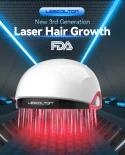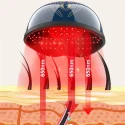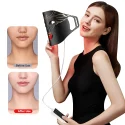2024-04-24
The quest for luscious, thick hair has spurred the development of various hair restoration technologies, including laser hair caps. These caps, often touted as a convenient and effective solution for hair loss, utilize low-level laser therapy (LLLT) to stimulate hair follicles and encourage regrowth. But amidst the promises and marketing buzz, the question lingers: Do laser hair caps truly deliver results? Let's delve into the science and evidence behind these devices to uncover the truth.
Understanding Low-Level Laser Therapy (LLLT)
LLLT, also known as photobiomodulation therapy, involves the use of low-energy laser light to stimulate cellular activity. The wavelengths of light emitted by LLLT devices penetrate the scalp and are absorbed by the hair follicles, where they purportedly trigger biochemical changes. These changes are thought to promote hair growth by extending the growth phase of hair follicles, increasing blood flow to the scalp, and reducing inflammation.
Examining the Research
Numerous studies have explored the efficacy of LLLT in treating hair loss, including randomized controlled trials and meta-analyses. While results have been somewhat mixed, there is evidence to suggest that LLLT can have a positive impact on hair growth for certain individuals.
A study published in the "American Journal of Clinical Dermatology" concluded that LLLT devices, including laser hair caps, showed a statistically significant increase in hair density compared to control groups. However, the degree of improvement varied among participants, suggesting that individual responses to LLLT may differ.
Another meta-analysis published in "Lasers in Surgery and Medicine" analyzed data from multiple studies and found that LLLT was associated with a moderate increase in hair count for individuals with androgenetic alopecia (pattern baldness). The analysis suggested that LLLT may be a valuable adjunctive therapy for hair loss.
The Role of Laser Hair Caps
Laser hair caps are designed to make LLLT more accessible and convenient for users. These caps typically contain medical-grade lasers or LEDs that emit specific wavelengths of light optimized for stimulating hair follicles. Users wear the cap for a specified duration per session, allowing the light to penetrate the scalp and potentially promote hair growth.
The benefits of laser hair caps include:
- Convenience: Users can wear the cap during various activities, making it easier to incorporate LLLT into their daily routines.
- Uniform Coverage: Caps provide consistent coverage of the entire scalp, ensuring that all areas receive treatment.
- Non-Invasive: LLLT is non-invasive and generally well-tolerated, with minimal side effects reported.
- Potential Hair Growth: Based on research findings, LLLT has the potential to improve hair density and quality for some individuals.
Considerations and Realistic Expectations
While laser hair caps hold promise, it's essential to manage expectations and consider several factors:
- Individual Variability: Response to LLLT can vary widely among individuals. Some may experience significant improvements, while others may see minimal changes.
- Consistency: Consistent use of the cap as directed is crucial for potential benefits. Skipping sessions or irregular usage may impact results.
- Complementary Treatments: LLLT is often used in conjunction with other hair loss treatments, such as topical solutions or oral medications, for enhanced results.
- Consultation: Consulting with a dermatologist or hair specialist can help determine if LLLT, including the use of a laser hair cap, is suitable for your specific hair loss pattern and needs.
Final Verdict
While scientific evidence supports the potential efficacy of LLLT, including laser hair caps, individual results may vary. Factors such as the underlying cause of hair loss, genetic predispositions, and adherence to treatment protocols can influence outcomes.
Ultimately, laser hair caps can be a valuable addition to a comprehensive approach to hair restoration for individuals seeking non-invasive options. By understanding the science behind LLLT and managing expectations realistically, users can make informed decisions about incorporating these devices into their hair care routines.
Desbloqueo de la piel radiante: el poder de los dispositivos de belleza de terapia de luz LED











